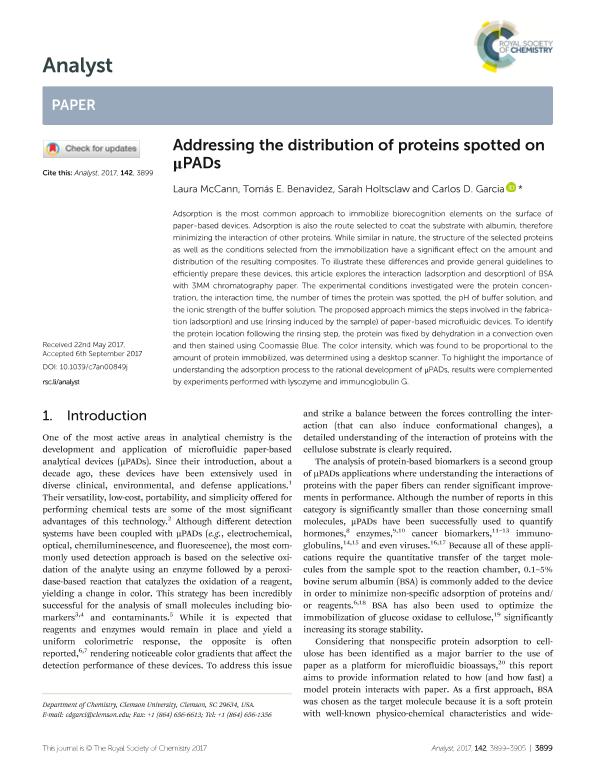Mostrar el registro sencillo del ítem
dc.contributor.author
McCann, Laura
dc.contributor.author
Benavidez, Tomás Enrique

dc.contributor.author
Holtsclaw, Sarah
dc.contributor.author
Garcia, Carlos D.

dc.date.available
2018-11-15T17:34:35Z
dc.date.issued
2017-10
dc.identifier.citation
McCann, Laura; Benavidez, Tomás Enrique; Holtsclaw, Sarah; Garcia, Carlos D.; Addressing the distribution of proteins spotted on μpADs; Royal Society of Chemistry; Analyst; 142; 20; 10-2017; 3899-3905
dc.identifier.issn
0003-2654
dc.identifier.uri
http://hdl.handle.net/11336/64552
dc.description.abstract
Adsorption is the most common approach to immobilize biorecognition elements on the surface of paper-based devices. Adsorption is also the route selected to coat the substrate with albumin, therefore minimizing the interaction of other proteins. While similar in nature, the structure of the selected proteins as well as the conditions selected from the immobilization have a significant effect on the amount and distribution of the resulting composites. To illustrate these differences and provide general guidelines to efficiently prepare these devices, this article explores the interaction (adsorption and desorption) of BSA with 3MM chromatography paper. The experimental conditions investigated were the protein concentration, the interaction time, the number of times the protein was spotted, the pH of buffer solution, and the ionic strength of the buffer solution. The proposed approach mimics the steps involved in the fabrication (adsorption) and use (rinsing induced by the sample) of paper-based microfluidic devices. To identify the protein location following the rinsing step, the protein was fixed by dehydration in a convection oven and then stained using Coomassie Blue. The color intensity, which was found to be proportional to the amount of protein immobilized, was determined using a desktop scanner. To highlight the importance of understanding the adsorption process to the rational development of μPADs, results were complemented by experiments performed with lysozyme and immunoglobulin G.
dc.format
application/pdf
dc.language.iso
eng
dc.publisher
Royal Society of Chemistry

dc.rights
info:eu-repo/semantics/openAccess
dc.rights.uri
https://creativecommons.org/licenses/by-nc-sa/2.5/ar/
dc.subject
Bovine Serum Albumin
dc.subject
Lysozyme
dc.subject
Inmunoglobulin G
dc.subject
Protein Adsorption
dc.subject
Upad
dc.subject.classification
Otras Ciencias Químicas

dc.subject.classification
Ciencias Químicas

dc.subject.classification
CIENCIAS NATURALES Y EXACTAS

dc.title
Addressing the distribution of proteins spotted on μpADs
dc.type
info:eu-repo/semantics/article
dc.type
info:ar-repo/semantics/artículo
dc.type
info:eu-repo/semantics/publishedVersion
dc.date.updated
2018-10-22T19:00:19Z
dc.journal.volume
142
dc.journal.number
20
dc.journal.pagination
3899-3905
dc.journal.pais
Reino Unido

dc.journal.ciudad
Cambrdge
dc.description.fil
Fil: McCann, Laura. Clemson University; Estados Unidos
dc.description.fil
Fil: Benavidez, Tomás Enrique. Consejo Nacional de Investigaciones Científicas y Técnicas; Argentina. Clemson University; Estados Unidos
dc.description.fil
Fil: Holtsclaw, Sarah. Clemson University; Estados Unidos
dc.description.fil
Fil: Garcia, Carlos D.. Clemson University; Estados Unidos
dc.journal.title
Analyst

dc.relation.alternativeid
info:eu-repo/semantics/altIdentifier/doi/https://dx.doi.org/10.1039/C7AN00849J
dc.relation.alternativeid
info:eu-repo/semantics/altIdentifier/url/https://pubs.rsc.org/en/Content/ArticleLanding/2017/AN/C7AN00849J
Archivos asociados
